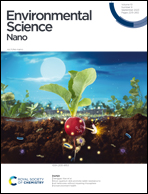Self-regenerable clay polymer nanocomposite for organophosphate adsorption and degradation†
Abstract
The presence of organophosphates in water has driven numerous studies to address organophosphate treatment, with adsorption being one of the most common methods. However, a holistic approach, pollutant adsorption and degradation by sorbent, sorbent reuse, efficiency, and selectivity, and the coexistence of dissolved organic matter (DOM) in water, was not pursued. We aimed to develop a self-regenerable clay–polymer nanocomposite (CPN), based on substituting an active oxime group on the polymer, to study its organophosphate degradation kinetics, mechanism, and efficiency in the presence of DOM. CPN characterization suggests that upon polymer immobilization, not only did oxime remain deprotonated and therefore active, but pKa was also reduced in comparison to the “free” polymer. The degradation kinetics of diazinon and paraoxon was relatively fast, with 70 and 40% degradation, respectively, at pH 7.6 and complete degradation at pH 9.6 within 30 hours. Based on kinetics results and the effect of pH on organophosphate adsorption and degradation, we suggested a three-step mechanism for diazinon and paraoxon degradation. The reuse of the CPN, five cycles of organophosphate degradation by the same CPN, was extremely impressive, with 90% diazinon degradation. Remarkably, on top of the successful diazinon and paraoxon degradation, in the presence of high DOM concentrations, the CPN efficiently removed 85% DOM. The simultaneous organophosphate degradation and DOM removal were attributed to the unique chemical structure of the CPN, which contains two independent sites, a negative functional group (oxime) for degradation and a positive functional group (pyridinium) for DOM adsorption.



 Please wait while we load your content...
Please wait while we load your content...